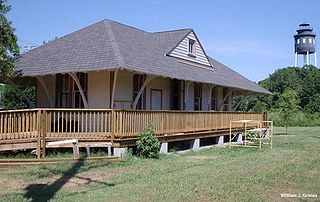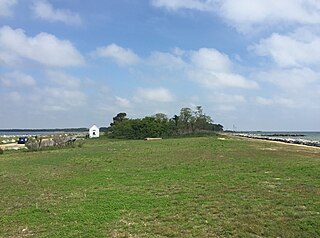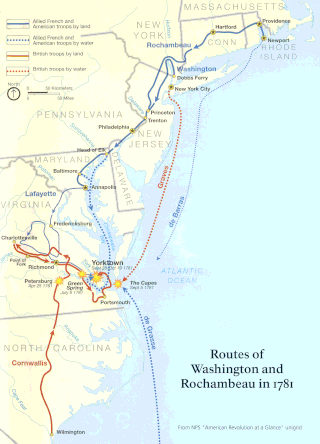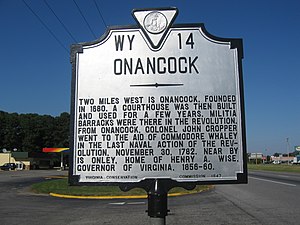
Onancock is a town in Accomack County, Virginia, United States. The population was 1,263 at the 2010 census.

Tangier is a town in Accomack County, Virginia, United States, on Tangier Island in the Chesapeake Bay. The population was 436 at the 2020 census. Since 1850, the island's landmass has been reduced by 67%. Under the mid-range sea level rise scenario, much of the remaining landmass is expected to be lost in the next 50 years and the town will likely need to be abandoned.
The first USS Virginia was a 28-gun sailing frigate of the Continental Navy, a ship with a short and unfortunate career.

The Province of Maryland was an English and later British colony in North America from 1634 until 1776, when it made common cause with the group of Thirteen Colonies in rebellion against Great Britain and, finally in 1781—as the 13th signatory to the Articles of Confederation—it ratified its perpetual union with that group as the state of Maryland. The province's first settlement and capital was St. Mary's City, located at the southern end of St. Mary's County, a peninsula in the Chesapeake Bay that is bordered by four tidal rivers.

The Eastern Shore of Virginia is the easternmost region of the Commonwealth of Virginia in the United States. It consists of two counties on the Atlantic coast. It is detached from the mainland of Virginia by the Chesapeake Bay. The 70-mile-long (110 km) region is part of the Delmarva Peninsula. Its population was 45,695 as of 2020.

Joshua Barney was an American Navy officer who served in the Continental Navy during the Revolutionary War and as a captain in the French Navy during the French Revolutionary Wars. He later achieved the rank of commodore in the United States Navy and also served in the War of 1812.

The Battle of Bladensburg, also known as the Bladensburg Races, took place during the Chesapeake Campaign, part of the War of 1812, on 24 August 1814, at Bladensburg, Maryland, 8.6 miles (13.8 km) northeast of Washington, D.C.

The Battle of Craney Island was a victory for the United States during the War of 1812. The battle saved the city of Norfolk, and the adjacent city of Portsmouth, from British invasion. Especially important to Virginia and northeastern North Carolina, the region was a major hub for American commerce.

The Battle of St. Michaels was an engagement contested on August 10, 1813, during the War of 1812. British soldiers attacked the American militia at St. Michaels, Maryland, which is located on Maryland's Eastern Shore with access to Chesapeake Bay. At the time, this small town was on the main shipping route to important cities such as Baltimore and Washington, D.C.

Point Lookout State Park is a public recreation area and historic preserve occupying Point Lookout, the southernmost tip of a peninsula formed by the confluence of Chesapeake Bay and the Potomac River in St. Mary's County, Maryland. The state park preserves the site of an American Civil War prisoner of war camp and the Point Lookout Light, which was built in 1830. It is the southernmost spot on Maryland's western shore, the coastal region on the western side of the Chesapeake Bay.

The Yorktown campaign, also known as the Virginia campaign, was a series of military maneuvers and battles during the American Revolutionary War that culminated in the siege of Yorktown in October 1781. The result of the campaign was the surrender of the British Army force of General Charles Earl Cornwallis, an event that led directly to the beginning of serious peace negotiations and the eventual end of the war. The campaign was marked by disagreements, indecision, and miscommunication on the part of British leaders, and by a remarkable set of cooperative decisions, at times in violation of orders, by the French and Americans.

The southern theater of the American Revolutionary War was the central theater of military operations in the second half of the American Revolutionary War, 1778–1781. It encompassed engagements primarily in Virginia, Georgia, North Carolina, and South Carolina. Tactics consisted of both strategic battles and guerrilla warfare.
The Battle of Caulk's Field was fought during the War of 1812 in Kent County, Maryland between a small British Army force commanded by Captain Sir Peter Parker and American militia forces commanded by Lieutenant Colonel Philip Reed. Parker, who was operating in the Chesapeake Bay region as part of the British campaign against Baltimore, Maryland, landed on the eastern shore of the Chesapeake Bay to move against Reed's militia encampment. The British attacking force encountered American skirmishers, who conducting a fighting retreat, drawing the British towards the main American line. Parker was mortally wounded during the fight, and the British force withdrew after Parker fell. Later British setbacks at the Battle of North Point and the Battle of Fort McHenry led the British to abandon their campaign against Baltimore. In 2012, the battlefield was the site of an archaeological survey.

The Chesapeake campaign, also known as the Chesapeake Bay campaign, of the War of 1812 was a British naval campaign that took place from 23 April 1813 to 14 September 1814 on and around the Delaware and Chesapeake bays of the United States.

Otho Holland Williams was a Continental Army officer from Maryland in the American Revolutionary War. He participated in many battles throughout the war in the New York, New Jersey and Southern theaters, eventually ending his career as a brigadier general.
Tangier Sound is a sound of the Chesapeake Bay bounded on the west by Tangier Island in Virginia, and Smith Island and South Marsh Island in Maryland, by Deal Island in Maryland on the north, and the mainland of the Eastern Shore of Maryland and Pocomoke Sound on the east. It stretches into Virginia as far south as Watts Island.

The history of Virginia in the American Revolution begins with the role the Colony of Virginia played in early dissent against the British government and culminates with the defeat of General Cornwallis by the allied forces at the Siege of Yorktown in 1781, an event that signaled the effective military end to the conflict. Numerous Virginians played key roles in the Revolution, including George Washington, Patrick Henry, and Thomas Jefferson.

Pungoteague Creek is a creek in Accomack County, Virginia, United States. Pungoteague Creek Light and Pungoteague, Virginia are named after this creek.

The Second Battle of St. Michaels was a raid conducted on Maryland's Eastern Shore by British soldiers during the War of 1812. The raid occurred on August 26, 1813, at points between Tilghman Island and the town of St. Michaels, Maryland. Local militia defended against the raiders.
















